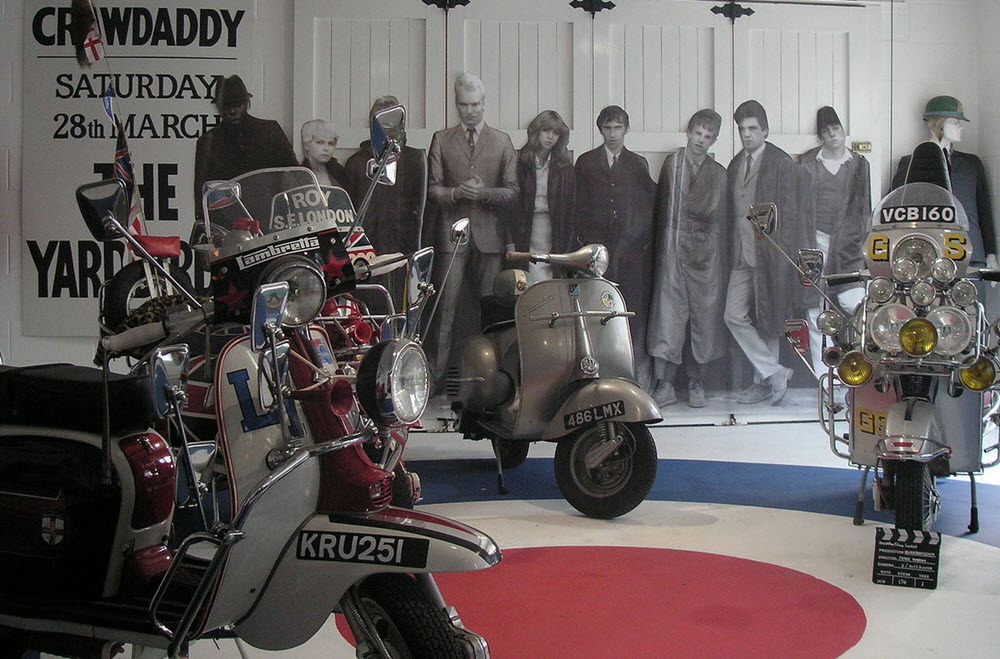An important element in the rock opera Quadrophenia is the protagonist´s identification with the subculture “mod”, and how he and his fellow mod friends are seeking out fights with members of the rivalling subculture rockers – all set in London and Brighton in 1964, and with a strong focus on working class youth.
Mod is a subculture that originated in London, and it has its roots in the “modernists”; stylish London-based young men who earned that moniker through their fondness for modern jazz.
Examples of elements typically associated with the mod subculture are well-fitting suits (for men) and motor scooters; especially Lambretta and Vespa. As with many other subcultures, music played a vital role, and the early English mod scene was strongly connected to soul, rhythm and blues, ska, and jazz. From the mid-1960s, the mod scene was instead dominated by power pop rock, such as the music made by The Who and The Small Faces.
The mod scene was also associated with all-night dancing at night clubs, and the drug of choice was amphetamine.

Clashes with rockers
During the early 1960s, violent clashes between mods and rockers occurred in Great Britain. They got a lot of media attention, and the mass-media of the time was very eager to simultaneously fan the flames and decry both the violence and the subcultures.
By the mid-1960s, the violence largely died down, as mods increasingly gravitated to artistic pursuits, pop art and psychedelia. Simultaneously, numerous rock bands in the United Kingdom adopted a mod look and catered to mod fans, and listening to rock was no longer anathema to mods.
Later mods
During the second half of the 1960s, the working class aspects of the mod scene diminished, and being mod instead became associated with trendy Carnaby Street boutiques and discothèques in London. It was during this period that the term Swinging London was coined. It is a period associated more with fashion model Twiggy and brightly coloured bold-patterned miniskirts than with proletarian youth violence.
As certain aspects of this “later” mod subculture spread from London to other parts of the world, it became seen as something emblematic of adolescence and young adulthood of the 1960s rather than being a narrow subculture for a small segment of society. In mass-media, the term mod began being used for almost anything that was considered popular, fashionable, modern and youthful.
In working class England, “street mods” splintered off from the now mainstream mod movement, and this eventually gave rise to the skinhead subculture.
Mod-revival
A mod-revival occurred in the UK in the late 1970s, followed by a similar revival in the United States and Canada in the early 1980s. In the U.S., the trend was especially noticeable in southern California.
On the British Isles, thousands of mod revivalists began attending scooter rallies in places such as Isle of Wight and Scarborough, partly inspired by the movie Quadrophenia which premièred in 1979. Examples of mod-influenced band that were a big influence during this epoch are The Lambrettas, The Chords, The Jam, and The Specials.
In southern California, the mod-revival was fuelled by bands such as The Untouchables, and was connected to the English 2 Tone ska revival.
The term mod
As mentioned above, mod is short for modernist. In the 1950s Britain, the term was used to describe adherents of modern jazz music, as opposed to the trad who played or listed to traditional jazz. (In this sense, it should not be confused with how the terms modernist and modernism apply to the broader fields litterature, architecture, art, and design.)
In Colin MacInnes 1959 novel “Absolute Beginners”, written and set in 1958 London, the modernists are described as young fans of modern jazz who dress sharp in modern Italian clothes.